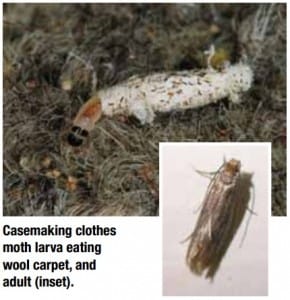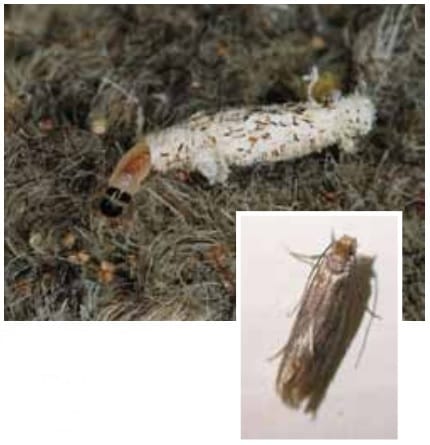 This is a casemaking clothes moth larva feeding on wool carpet with an adult moth (inset). Clothes moth larvae feed on items of animal origin (feathers, wool, etc.) and can permanently damage items made from animal products – clothes, carpet, etc.
This is a casemaking clothes moth larva feeding on wool carpet with an adult moth (inset). Clothes moth larvae feed on items of animal origin (feathers, wool, etc.) and can permanently damage items made from animal products – clothes, carpet, etc.
This information is taken from the UGA publication, Management of Pest Insects in and Around the Home
Clothes moths (Tineidae: Tineola and Tinea spp.): Shiny, light gold-colored, 1/4 inch moth with fringed wing margins. The most common species in Georgia is the casemaking clothes moth (Tinea pellionella). Larvae of casemaking clothes moths build rectangular to elliptical cases about 1/4 inch that are open at both ends and spun from materials and/or fibers in their immediate environment, often fibers they have been feeding on. Larvae live, protected, inside the case. Larvae have a dark band just behind their head, which is visible only when the larva projects its head out of the case to feed.
Habits: Moths fly at night, usually in an erratic pattern, in search of mates and food. Adults lay eggs on items of animal origin, commonly feathers and wool. Larvae crawl around and on the item while feeding from inside their case. In preparation for pupation, larvae of the casemaking clothes moth crawl away from the item they are infesting and attach their case to the wall or other nearby vertical surface.
Interventions: Wash, steam-clean or dry-clean all items of animal origin, especially wool. Have infested textiles professionally cleaned. If items cannot be washed or steam-cleaned (large quantities of material, such as area rugs) then consider small-scale fumigation or storage for at least a month in a freezer. Before cleaned items are put back in the home, remove, by hand, visible pupal cases from vertical surfaces and from shelves. Consider storing susceptible fabrics in sealed containers to prevent re-infestation. Use pheromone traps to capture male moths. If desired, apply a spot treatment with an appropriately labeled residual spray to the area where moths and larvae are found.
Might Be Confused With: Indianmeal moths; other, small, incidental moths that fly indoors, from outdoors, when doors are open.
For more information on control:
Look under Fabric Pests here for non-chemical controls
